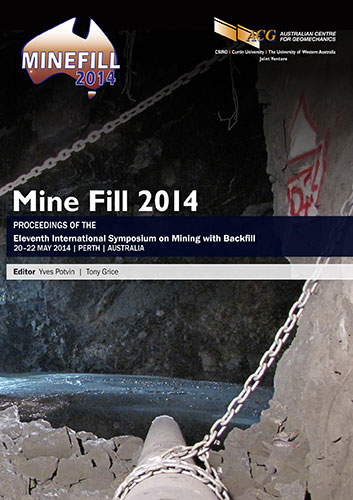Experiment and analysis of hydration mechanisms on the new backfilling cementitious materials

|
Authors: Li, M; Gao, Q; Yang, Z; Wang, YT Paper is not available for download Contact Us |
DOI https://doi.org/10.36487/ACG_rep/1404_25_Li
Cite As:
Li, M, Gao, Q, Yang, Z & Wang, YT 2014, 'Experiment and analysis of hydration mechanisms on the new backfilling cementitious materials', in Y Potvin & T Grice (eds), Mine Fill 2014: Proceedings of the Eleventh International Symposium on Mining with Backfill, Australian Centre for Geomechanics, Perth, pp. 317-323, https://doi.org/10.36487/ACG_rep/1404_25_Li
Abstract:
The experimental research discussed in this paper uses lime, gypsum, slag and other solid wastes to get new cementing materials that can replace the cement for Sijiaying iron ore tailings. X-ray diffraction (XRD) and scanning electron microscopy (SEM) are employed to analyse the hydration mechanism of the activator in the new cementing materials, thereby determining the optimum ratio of activator. The research has shown that the new cementing materials’ strength can meet the requirements of staged backfill in Sijiaying when the solids concentration is 68%, mortar ratio is 1:8, lime is 3.5%, and gypsum is 16%. The results show that new cementitious sand has a more compact structure and coarse occurrence, when compared with cement mortar using SEM and XRD to observe and analyse the hydration products and microstructure. The hydration products are mainly AFt crystals and calcium silicate hydrate (C-S-H) gel, which greatly improves the novel cementitious sand strength. The new cementitious material has higher strength and lower cost than cement. It can effectively reduce the filling costs and improve mining efficiency in the low-grade iron deposit, which uses cut and fill mining method. The research of new cementitious material can lay the foundation for safe, efficient and environmentally sound development for a low-grade iron deposit.
References:
Cayoutte, J 2003, ‘Optimization of the paste backfill plant of Louvicourt Mine’, CIM Bulletin, vol. 96, no. 1095, pp. 51-7.
Chen, SF & Zhou, WK 2000, ‘Studies on hydration mechanism of slag powder cement’, Journal of Xi'an University of Architecture & Technology, vol. 32, no. 2, pp. 166-9.
Dong, L, Gao, Q & Nan, SQ 2013, ‘Performance and hydration mechanism of new super fine cemented whole-tailings backfilling materials’, Journal of Central South University (Science and Technology), vol. 44, no. 4, pp. 1571-7.
Hou, L, Li, JH & Wang, HL 2011, ‘Mechanical property and hydration mechanism of slag blended magnesium phosphate cement’, Acta Petrologica ET Mineralogica, vol. 30, no. 4, pp. 721-6.
Li, SQ, Liu, LJ & Ruan, QF 2011, ‘Study on hydration mechanism of gypsum slag cement’, Bulletin of the Chinese Ceramic Society, vol. 30, no. 1, pp. 230-3.
Ma, ZZ, Yue, HW & Song, XL 2009, ‘The mechanism, test and effect factors of cement hydration process’, Journal of Changsha University, vol. 23, no. 2, pp. 43-6.
Wang, XM, Guo, HD & Zhao, B 2011, ‘Proportion optimization of cemented tailing materials in Jiaojia Gold Mine’, Mining Research and Development, vol. 31, no. 2, pp. 27-9.
Zhang, DM, Wang, L & Zhao, B 2010, ‘Cemented backfilling technology with unclassified tailings based on active materials’, China Mine Engineering, vol. 39, no. 2, pp. 6-10.
Zhao, CQ & Hu, NL 2008, ‘Application and practice of new filling material in Jiaojia Gold Mine’, Nonferrous Metals, vol. 60, no. 2, pp. 129-33.
© Copyright 2024, Australian Centre for Geomechanics (ACG), The University of Western Australia. All rights reserved.
View copyright/legal information
Please direct any queries or error reports to repository-acg@uwa.edu.au
View copyright/legal information
Please direct any queries or error reports to repository-acg@uwa.edu.au